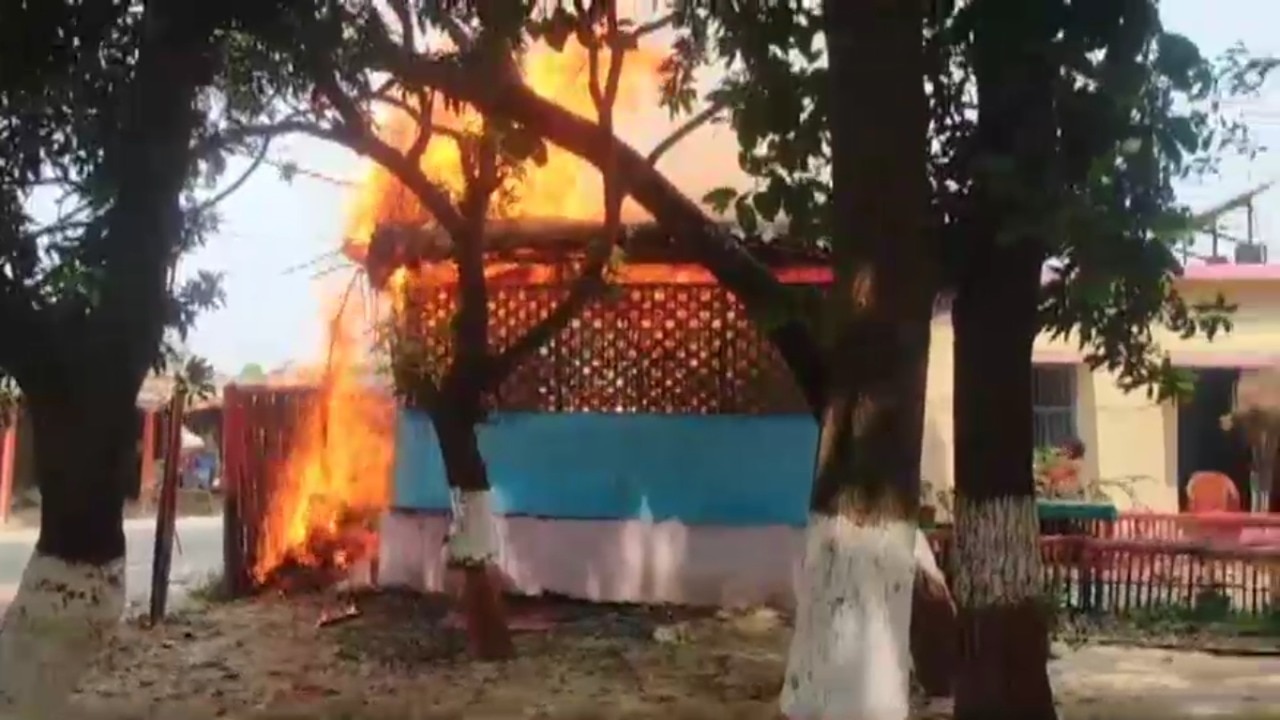'Raghupati Raghav Raja Ram, Patita Pavan Sitaram'
The devotional song was played inside Ayodhya's Ram Mandir on the day Prime Minister Narendra Modi led the Pran Pratishtha rituals. Nearly 1,300 km away, Congress leaders, including Rahul Gandhi, staged a protest on road in Assam's Nagaon, chanting the same devotional song, but with a slight difference.
Rahul Gandhi was stopped at Haibargaon en route to the birthplace of Vaishnav saint Srimanta Sankardeva. According to the police, Rahul Gandhi was barred from visiting the birthplace of the iconic Vaishnav saint on the ground that a law and order problem may arise during his visit as many organisations were planning to hold events related to the consecration of the Ram Mandir.
Rahul Gandhi and other senior Congress leaders and supporters staged a dharna, singing the Ramdhun which was immortalised in Indian politics by Mahatma Gandhi. But the lyrics of their Ramdhun is different from the one played at the Ayodhya temple.
THE ORIGIN OF 'RAGHUPATI RAGHAV RAJA RAM'
There are different versions of the origin of the devotional song. While some credit Tulsidas, who wrote Ramcharitmanas, for the bhajan, some accounts say 17th-century Marathi poet-saint Ramdas created it.
Whatever the origin of the bhajan, its lyrics were deeply rooted in the lore of Lord Ram.
àä°àäàåàäªàääàä¿ àä°àä¾àäàäµ àä°àä¾àäàä¾àä°àä¾àä®
àäªàääàä¿àää àäªàä¾àäµàäè àä¸àåàääàä¾àä°àä¾àä®
àä¸àåàäàäæàä° àäµàä¿àäàåàä°àä¹ àä®àåàäàä¶àåàäïàä¾àä®
àäàäàäàä¾ àääàåàä²àä¸àå àä¶àä¾àä²àäàåàä°àä¾àä®
àäàäæàåàä°àäàä¿àä°àåàä¶àåàäµàä° àä¸àåàääàä¾àä°àä¾àä®
àäàäàää àäàäèàäªàåàä°àä¿àäï àä¸àåàääàä¾àä°àä¾àä®...#àä°àä¾àä®_àäàä¾_àäàäµàåàäï_àäçàä¾àä® pic.twitter.com/5OBYDfl3yS
— BJP (@BJP4India) January 22, 2024
Here's how the original lyrics read:
Raghupati Raghav Raja Ram
Patita Pavan Sitaram
Sundar Vigraha Meghashyam
Ganga Tulasi Shaaligram
Bhadhra Girishwar Sitaram
Bhagat Janapriya Sitaram
Janaki Ramana Sitaram
Jaya Jaya Raghava Sitaram
In 'Gandhi's Philosophy and the Quest for Harmony', Anthony Parel writes, "[T]he origin of Ramdhun is shrouded in legend. According to the legend that he preferred it was composed by the great Hindu poet Tulsidas (1532-1623). While on a pilgrimage visiting the Vishnu temple of Dakore, Northern India, Tulsidas was moved to bargain with Vishnu. Until Vishnu revealed himself as Rama he would not bow his head in prayer. His wish was promptly granted: Rama appeared in his mind with his wife Sita, and three of their devotees. Hence, explains Gandhi, 'Ramdhun, meaning intoxication with God'."
MAHATMA GANDHI'S 'RAGHUPATI RAGHAV RAJA RAM' VERSION
Mahatma Gandhi's affinity to Ram began in his childhood. In his autobiography 'My Experiments with Truth', Gandhi mentions that in his younger days, he was urged by his nurse Rambha to take the name of Ram when in fear.
"I have said before that there was in me a fear of ghosts and spirits. Rambha, for that was her name, suggested, as a remedy for this fear, the repetition of Ramanama. I had more faith in her than in her remedy, and so at a tender age I began repeating Ramanama to cure my fear of ghosts and spirits. This was of course short-lived, but the good seed sown in childhood was not sown in vain. I think it is due to the seed sown by that good woman Rambha that today Ramanama is an infallible remedy for me," Gandhi wrote in his autobiography.
In her book 'The Sounds of Satyagraha: Mahatma Gandhi's use of sung-prayers and ritual', author Cynthia Snodgrass writes that 'Raghupati Raghava Raja Ram' was chanted during the Dandi March in 1930 and "there were, and are, several versions of Ramdhun in vogue".
Here are the lyrics of Mahatma Gandhi's version of the devotional song:
Raghupati Raghav Raja Ram
Patita Pavan Sitaram
Sitaram, Sitaram,
Bhaj Pyare tu Sitaram
Ishwar Allah Tero Nam,
Sabako Sanmati De Bhagawan
According to Snodgrass, the version that Gandhi used had an ecumenical flavour to it.
"The third line read that the Ishwar of the Hindus and the Allah of the Muslims were one and the same," notes Snodgrass.
In an article published in Young India on January 22, 1925, Mahatma Gandhi wrote “Rama, Allah and God are to me convertible terms”.
Mahatma Gandhi made specific reference to his grand-niece, Manu, having been with him to Noakhali (now in Bangladesh), where communal riots broke out in 1946.
"During that tour, she found a melodious tune. Of course, she has not composed it. It is more true to say that God prompted her to say: 'Ishvar Allah tere nam sabko sanmati de Bhagawan.' In a speech given at the Inter-Asian Relations Conference on April 2, 1947, Gandhi declared: 'I am not postponing the prayer out of fear. If anybody wants to stop me once I have started the prayers I shall not stop even if I am killed. And you will see I shall be reciting Rama Rahim and Krishna Karim when I breathe my last'," notes Snodgrass.
In fact, after his return from Noakhali, Mahatma Gandhi replaced the refrain 'Bhaj Mann Pyare Sitaram' by 'Bhaj Mann pyare Rama Rahim, Bhaj Mann Pyare Krishna Karim', notes Snodgrass.
Mahatma Gandhi's version of Ramdhun became the very basis of Nehruvian secularism, as the devotional song derived communal harmony and a promise of Ram Rajya in a "non-religious" context.
As Mahatma Gandhi affirms in another article published in Harijan on April 28, 1946, the idea that the Ram of which he spoke had no correspondence to "the historical Rama, the ruler of Ayodhya and the son of King Dasharatha".
While on Monday (January 22) the original version of the devotional song was played in Ayodhya, the Congress protest saw the singing of the Mahatma's version.
Published By:
Rishabh Sharma
Published On:
Jan 22, 2024

 3 months ago
32
3 months ago
32








 English (US) ·
English (US) ·